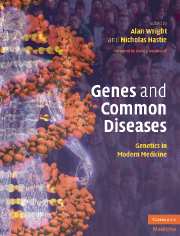Book contents
- Frontmatter
- Contents
- List of Contributors
- Foreword
- Section 1 Introductory Principles
- 1 Genes and their expression
- 2 Epigenetic modification of chromatin
- 3 Population genetics and disease
- 4 Mapping common disease genes
- 5 Population diversity, genomes and disease
- 6 Study design in mapping complex disease traits
- 7 Diseases of protein misfolding
- 8 Aging and disease
- 9 The MHC paradigm: genetic variation and complex disease
- 10 Lessons from single gene disorders
- 11 Environment and disease
- 12 Contemporary ethico-legal issues in genetics
- Section 2 Common Medical Disorders
- Index
- References
1 - Genes and their expression
Published online by Cambridge University Press: 17 August 2009
- Frontmatter
- Contents
- List of Contributors
- Foreword
- Section 1 Introductory Principles
- 1 Genes and their expression
- 2 Epigenetic modification of chromatin
- 3 Population genetics and disease
- 4 Mapping common disease genes
- 5 Population diversity, genomes and disease
- 6 Study design in mapping complex disease traits
- 7 Diseases of protein misfolding
- 8 Aging and disease
- 9 The MHC paradigm: genetic variation and complex disease
- 10 Lessons from single gene disorders
- 11 Environment and disease
- 12 Contemporary ethico-legal issues in genetics
- Section 2 Common Medical Disorders
- Index
- References
Summary
The completion of the human genome project has heralded a new era in biology. Undoubtedly, knowledge of the genetic blueprint will expedite the search for genes responsible for specific medical disorders, simplify the search for mammalian homologues of crucial genes in other biological systems and assist in the prediction of the variety of gene products found in each cell. It can also assist in determining the small but potentially significant genetic variations between individuals. However, sequence information alone is of limited value without a description of the function and, importantly, of the regulation of the gene products. Our bodies consist of hundreds of different cell types, each designed to perform a specific role that contributes to the overall functioning of the organism. Every one of these cells contains the same 20 000 to 30 000 genes that we are estimated to possess. The remarkable diversity in cell specialization is achieved through the tightly controlled expression and regulation of a precise subset of these genes in each cell lineage. Further regulation of these gene products is required in the response of our cells to physiological and environmental cues. Most impressive perhaps is how a tightly controlled program of gene expression guides the development of a fertilised oocyte into a full-grown adult organism. The human genome has been called our genetic blueprint, but it is the process of gene expression that truly brings the genome to life.
- Type
- Chapter
- Information
- Genes and Common DiseasesGenetics in Modern Medicine, pp. 3 - 19Publisher: Cambridge University PressPrint publication year: 2007



